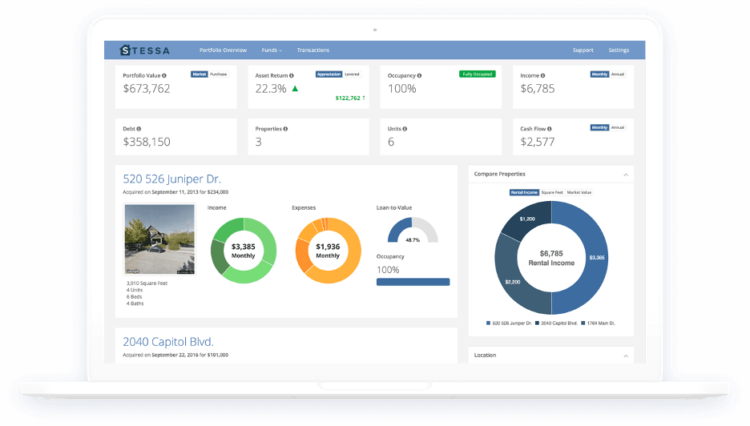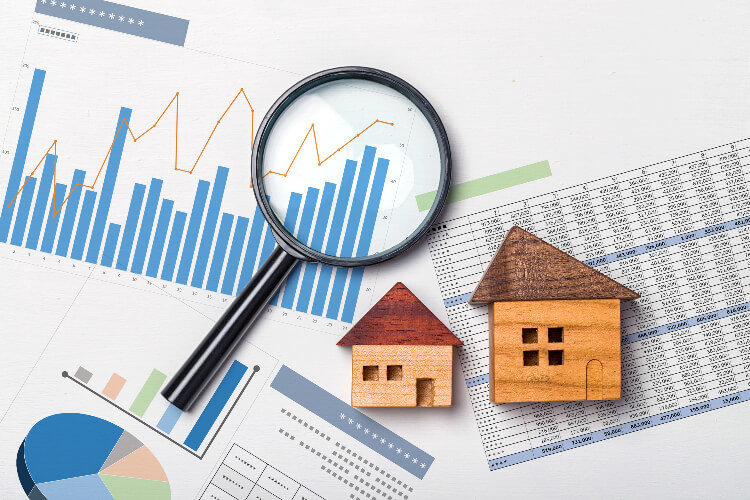There’s an old saying that goes, “You can’t really know where you are going until you know where you have been.” That’s true in life, and especially true when you’re investing in real estate.
Real estate investors use a rental income and expense worksheet to accurately track cash flow each and every month, calculate return on investment or “ROI,” identify opportunities to increase revenues, and make sure they are claiming every tax deduction the IRS allows.
In this article, we’ll take an in-depth look at the rental income and expense worksheet, including a quick and easy way to accurately track the financial performance of rental property to help maximize potential profits.

Rental Income and Expenses According to the IRS
Let’s begin by going right to the source. According to IRS Topic No. 414 Rental Income and Expenses:
“Cash or the fair market value of property or services you receive for the use of real estate or personal property is taxable to you as rental income. In general, you can deduct expenses of renting property from your rental income.”
Rental Income
- Regular rent received from the tenant;
- Advance rent received (such as the first and last month of rent);
- Lease cancellation fees; and
- Expenses paid by the tenant in lieu of rent (like painting the house in exchange for free).
Security deposits are not treated as rental income if they are meant to be refunded to the tenant. Instead, a rental security deposit is recorded as a liability on the property balance sheet.
However, there are three instances when a security deposit does become rental income:
- Part or all of the rental security deposit is used to pay for damages caused by the tenant beyond normal wear and tear;
- The security deposit is kept all or in part after the tenant breaks the lease and moves out early; or
- The security deposit is used to pay the tenant’s last month of rent.
Rental Expenses
- Operating expenses (such as maintenance, repairs, landscaping, and property management);
- Property taxes and mortgage interest payments;
- Owner business and travel expenses directly related to the property (such as visiting an out-of-state property in person);
- Depreciation to allow for the exhaustion, wear and tear of the property (a non-cash expense used to reduce taxable net income using IRS Form 4562 Depreciation and Amortization).

Loss Limitations and Depreciation
As long as a property is used as an investment intended to make a profit and not as the owner’s primary residence, deductible rental expenses can be more than the gross rental income, subject to certain limits.
Negative net income can occur when a vacant property is first purchased and the landlord is looking for a tenant. There’s no monthly rental income coming in, but operating expenses and the mortgage must still be paid.
Depreciation expenses can also create a loss by reducing taxable net income. The IRS allows residential rental property to be depreciated over a period of 27.5 years, excluding the land or lot because land does not wear out. If the cost of a home is $150,000 (not counting the lot) the annual full year depreciation would be $5,455 ($150,000 / 27.5 years).
For example, if the annual pre-tax income from a property is $5,000 and the depreciation expense taken is $5,455, the property would have a negative income of $455 for tax purposes even though there is positive cash flow of $5,000.

How to Keep Accurate Rental Property Records
There are several reasons why keeping accurate records for a rental property makes good business sense.
First, accurately keeping records for a rental property lets you know if you are really making a profit, and helps you strategize on ways to maximize profits. Secondly, accurate records also make it easier to claim every deduction you are entitled to as a real estate investor. Last but not least, good record keeping also provides a paper trail if you are ever audited by the state or federal government.
There are two categories of rental property records:
- Income and expenses in an itemized list or report format.
- Paper trail consisting of backup or supporting documents to show reported income and expense deductions are true and correct.
Types of Rental Property Records
There is a surprisingly large amount of paperwork to keep track of as a landlord, even when you are just getting started and own only one rental property:
- Settlement statement and closing documents to determine property basis for depreciation purposes;
- Property management agreement(s) indicating new account opening and monthly fees;
- Initial billing from utility companies to track refundable security deposits paid;
- Copies of current and previous tenant leases going back at least three years ;
- Documents and expenses related to the leases, including application fees, security deposits paid, and leasing commissions or legal expenses for an eviction;
- Amount and date of rent payments received from tenants (having renters pay online may generate an automatic paper trail);
- Bank statements set up specifically for your rental property business to keep personal and business expenses separate and prove that you aren’t commingling money;
- Statements from utility companies, vendors and handymen, receipts for supplies and labor, and other operating expenses directly related to the rental property;
- Advertising, marketing, and tenant screening expenses such as background and rental history checks and online lease preparation;
- Professional service fees paid to an attorney, accountant, or property management company;
- Mortgage documents, property tax assessments, Form 1098 used to report mortgage interest paid for the year, and proof of loan payments made;
- Copies monthly use or sales tax forms showing rental tax paid to the city and state;
- Federal and state tax return copies going back several years.
Some real estate investors eventually grow their business to the point where they need a part-time or full-time salaried employee. Any salaries, benefits, payroll taxes withheld, and employer taxes also need to be tracked and reported on a quarterly and year-end basis.

Keeping Track of Rental Income and Expenses
It’s easy to quickly become overwhelmed by a seemingly countless number of documents and receipts that need to be kept track of.
Some investors create their own income and expense worksheet template using a simple Excel spreadsheet, OpenOffice, or Google Sheets. Other rental property owners prefer not to reinvent the wheel and use a free online system to keep track of rental property income and expenses.
Business Accounting Programs
Business and personal accounting programs used by real estate investors include FreshBooks, TurboTax, QuickBooks Online, Quicken, Xero, and Wave. These off-the-shelf programs are a good match for real estate investors who understand accounting and enjoy doing their own bookkeeping.
It can take a little time and effort to set up the programs to properly account for rental property income and expenses. Before purchasing the software or committing to a monthly subscription, try to download a free demo version to make sure the program does everything you need and want.
Set up a sample rental property, enter your business banking information, create a tenant, and book income and expenses for single and multiple properties. After that, generate monthly and year-end financial statements to make sure the program is easy to use and tracks every transaction properly.
Real Estate Specific Software
Rental property owners looking for a real estate-specific software often consider options such as Rezedent, TenantCloud, and Stessa.
Of these three, many real estate investors find that Stessa is the ideal system for automating income and expense tracking with a paper trail, and managing the financial performance of rental property. The software is perfect for smaller investors with one or two rental properties, as well as sophisticated investors with a large portfolio of rental properties.
It only takes a few minutes to create a free account, enter each property address, and link your business bank accounts. After that, personalized reporting will help you to maximize profits through smart money management and real-time reporting.
This real estate financial software has a mobile app for iOS and Android, and Stessa is 100% free.

Filing Rental Income and Expenses with the IRS
When tax time comes around, rental property owners can visit the Stessa Tax Center to get a free tax package or fill out and file IRS forms on their own.
Rental Property Tax Return Forms
There are two main forms real estate investors use to report income and expenses to the IRS:
- IRS Form 1040 or Form 1040-SR, Schedule E, Part I is used to report income, expenses, and depreciation for each property. Investors who have more than three rental properties must attach additional Schedule Es.
- Form 4562 is used to calculate the amount of rental property depreciation shown on Schedule E.
Occasionally rental property expenses are greater than rental income, such as when a vacant property is first purchased and the landlord is looking for a qualified tenant. Annual losses from a rental property may be limited due to passive activity loss rules and at-risk rules. Review Form 8542 Passive Activity Loss Limitations and Form 6198 At-Risk Limitations to learn if your loss is limited.
Income and Expense Records to Keep
The best system for tracking rental property income and expenses helps to monitor and improve property financial performance, prepare income statements and tax returns, and create a paper trail to identify the source of receipts and support data entered on tax returns.
If you are selected by the state or IRS for a routine audit, you may be asked to prove that the information reported on your tax return is accurate.
The auditor may require you to provide copies of receipts, canceled checks and invoices, and prove that any travel or business expenses are directly related to the rental property. Failure to provide evidence that satisfies the IRS may result in additional taxes and penalties.
Additional Information on IRS Rental Property Tax Rules
Real estate investors who want to learn more about the IRS rules and regulations for rental real estate may visit the following links:
- Know the Facts About Renting Out Residential Property
- IRS Tips on Rental Real Estate Income, Deductions, and Rental Recordkeeping
- IRS Publication 527 Residential Rental Property
- IRS Publication 946 How to Depreciate Property
- Single Member Limited Liability Companies (LLCs)

Use Rental Income and Expenses to Analyze Rental Property
A good rental income and expense worksheet makes analyzing the current performance of property and additional investments much easier. The gross income, net income, and cash flow reported on the worksheet are used in a variety of other rental property calculations including:
- Price to Rent Ratio compares the median home price to the median annual rent and is used to predict the potential demand for rental property;
- Gross Rent Multiplier (GRM) measures the property price to the gross annual rental income and is used to calculate the potential profitability of similar properties in the same market;
- Net Operating Income (NOI) is the total of all income received minus all expenses paid, excluding the mortgage payment;
- Cap Rate is a ratio that compares NOI to property value or sales price and is used to measure potential return from a rental property;
- Cash Flow is the cash remaining after all rental income has been received and all operating expenses have been paid, including the mortgage;
- Cash on Cash Return measures the annual pre-tax cash flow received compared to the amount of cash invested and will vary based on the amount of cash invested and the down payment used when financing;
- Return on Investment (ROI) measures the annual return of an investment compared to the total amount invested.






